Research - (2022) Volume 10, Issue 2
Knowledge, Awareness and Practices Regarding Hand Hygiene among Dental Students
Aathira CM and Santhosh Kumar MP*
*Correspondence: Santhosh Kumar MP, Department of Oral Surgery, Saveetha Dental College, Saveetha Institute of Medical and Technical Sciences, Saveetha University, India, Email:
Abstract
Introduction: Hand hygiene is of significant importance for the prevention of healthcare associated infections. There is a need to explore the concept of hand hygiene among the undergraduate dental students. The five moments that call for the use of hand hygiene include the moment before touching a patient, before performing aseptic and clean procedures, after being at risk of exposure to body fluids, after touching a patient, and after touching patient surroundings. This concept has been aptly used to improve understanding, training, monitoring, and reporting hand hygiene among healthcare workers. The aim of the study is to assess the knowledge, awareness and practice of hand hygiene among dental students. Materials and methods: This study was a cross sectional study, conducted among 100 undergraduate dental students belonging to third year, final year of study. Nine closed-ended questions were circulated online and the data was statistically analyzed using SPSS software. Statistical analysis was done using Chi square tests. Results: From the results obtained, it is evident that 81% of the students were aware about the hand hygiene protocol, 66% of the students have received formal training regarding hand hygiene, 68% of the students followed proper hand hygiene protocol and 51% of students felt that gloves do not eliminate the need for hand washing. Conclusion: Within the limitations of the study, it can be concluded that dental students were well aware about the hand hygiene protocol and its importance. Among the study population females were more aware about hand hygiene protocol and its importance than the males. However, hand hygiene practices to be followed and awareness must be created to a larger population of students.
Keywords
Hand hygiene, Innovative technology, Dental students, Prevention, Awareness, Knowledge
Introduction
Healthcare-associated infections are of prime concern when it comes to patient safety [1]. Hand hygiene remains the first and foremost step to reduce nosocomial infections from advanced healthcare systems to local dispensaries in developing countries [2]. The obedience regarding hand hygiene measures among healthcare workers and dental students tends to be low in spite of the simplicity and basic procedure to maintain tidy hands in between treating patients [2-4]. It was found that several barriers accompanied compliance of hand hygiene among dental students [5]. Dentists are exposed to blood, saliva and oral fluids. There is more chance for transmission of infections in the dental operatory through various means, like direct contact with blood, oral fluids, or other secretions; indirect contact with contaminated instruments, operatory equipment, or environmental surfaces; or contact with airborne contaminants present in either droplet splatter or aerosols of oral and respiratory [6]. Current CDC guidelines recommend the usage of alcohol-based hand sanitizer immediately before touching a patient, before handling invasive medical devices, after contact with blood, body fluids or 3 contaminated surfaces and immediately after removal of gloves [7].
Further, failure of hand hygiene practices action leads to elevated degree of hand contamination during incessant patient care. Both duration of care and the type of patient care can influence the healthcare worker's hand contamination [8]. Gloves protect hands from direct contact with pathogens during patient care but the same contaminated gloves have the ability to cross transmit the pathogens via gloved hands [9]. Gloved or ungloved hands, which does not account as it is always insisted for good hand hygiene practices during health care practices [10]. In spite of various strategies and efforts made to improve hand hygiene, there is still a lack of improved hygiene practices [11]. Various factors tend to affect hand hygiene practices which include personal knowledge of hand hygiene, perception of the benefits, professional background, gender, infectious disease severity, work intensity and presence of facilities [12].
Preventive strategies should be implemented to interrupt the chain of transmission, of which hand hygiene is the single most effective and cheapest measure available [13-15]. Anyway, the knowledge on hand hygiene still lacks in the majority of the students [16].
Any person involved in direct or indirect patient care, therefore needs to be concerned about HH and should be able to perform it correctly at the right time [17]. It has been calculated that about 4% of the acute care hospitalizations had one or more nosocomial infections [18]. In developed countries, nosocomial infections affect 5–15% of hospitalized patients [19].
Several studies have been conducted to assess the knowledge, awareness and practice of hand hygiene among healthcare workers, nurses and medical students. There is a lack of studies that emphasizes the importance of this topic in dental students. Our team has extensive knowledge and research experience that has translated into high quality publications [20-39]. The aim of the study was to assess the knowledge, awareness and practice regarding hand hygiene among dental students.
Materials and Methods
This study was a cross sectional study, conducted in a dental institute. A total of 100 undergraduate dentalstudents were involved in this study. The duration of the study was from January 2021 to March 2021.The participants of the study were undergraduate third year, final year students. The first and secondyear students were excluded from the study as they had not yet begun their clinical training.
Questionnaire
A validated questionnaire of 9 questions related to hand hygiene and infection control in dental hospitals was prepared. The questionnaire was structured, close ended and designed in the English language. There were three sections of the questionnaire. The first section covered the demographic profile including details regarding age, sex, and education. The other sections included questions to evaluate the knowledge, awareness and practices of dental students towards hand hygiene (Table 1).
| S.no | Questions | Responses | Cumulative percentage |
|---|---|---|---|
| 1 | Age | 18-25 years | 100% |
| 2 | Sex | Male | 52% |
| Female | 48% | ||
| 3 | Are you aware of the hand hygiene protocol? | Yes | 79% |
| No | 21% | ||
| 4 | Did you receive formal training for hand hygiene during your course of study? | Â Yes | 65% |
| No | 35% | ||
| 5 | Do you follow the protocol for hand washing to wash your hands regularly? | Yes | 69% |
| No | 31% | ||
| 6 | According to you, which of the following explains the need for hand hygiene? | Cleaning the hands | 36% |
| Breaking the cycle of infection | 46% | ||
| Decontaminating the skin | 15% | ||
| Cleaning an open wound | 3% | ||
| 7 | What is the minimal time for hand washing? | 10 sec | 23% |
| 20 sec | 55% | ||
| 30 sec | 17% | ||
| 40 sec | 5% | ||
| 8 | What is the duration for the entire procedure along with drying of hands? | 10-15 sec | 25% |
| 20-30 sec | 39% | ||
| 30-40 sec | 22% | ||
| 40-60 sec | 14% | ||
| 9 | How many steps are there in hand washing? | 3 | 26% |
| 7 | 43% | ||
| 8 | 22% | ||
| 9 | 9% | ||
| 10 | Which is the most efficient hand hygiene method? | Plain soap and water | 31% |
| Anti-microbial soap and water | 51% | ||
| Alcohol based hand rub | 18% | ||
| 11 | Do gloves eliminate the need for hand hygiene? | Yes | 31% |
| No | 53% | ||
| Don't know | 16% |
Table 1: Questionnaire regarding knowledge, awareness and practices towards hand hygiene among dental students.
Statistical analysis
The variables were coded and the data was imported to SPSS Version 20 categorical variables were expressed in terms of frequency and bar graphs were plotted. The statistical significance of the associations were tested using Chi square tests [p<0.05 is considered as statistically significant].
Results
In Figure 1, 81% of students were aware about the hand hygiene protocol whereas 19% of the students were not aware. Collectively among males and females, females were more aware about the hand hygiene protocol. In Figure 2, 66% of students received formal training during their course of study whereas 34% of students did not receive formal training during their course of study. Collectively among third years and fourth years, fourth years received more formal training than third years during their course of study. In Figure 3, 70% of students follow proper hand hygiene protocol regularly whereas 30% of students do not follow proper hand hygiene protocol regularly. Collectively among third years and fourth years, fourth years follow proper hand hygiene protocol than third years.
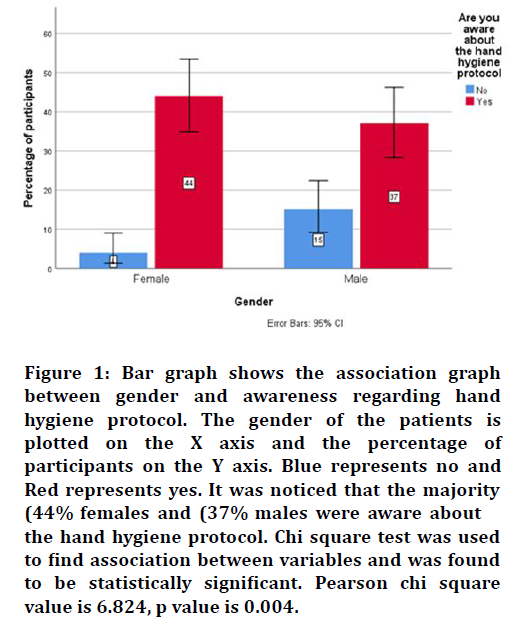
Figure 1. Bar graph shows the association graph between gender and awareness regarding hand hygiene protocol. The gender of the patients is plotted on the X axis and the percentage of participants on the Y axis. Blue represents no and Red represents yes. It was noticed that the majority (44% females and (37% males were aware about the hand hygiene protocol. Chi square test was used to find association between variables and was found to be statistically significant. Pearson chi square value is 6.824, p value is 0.004.
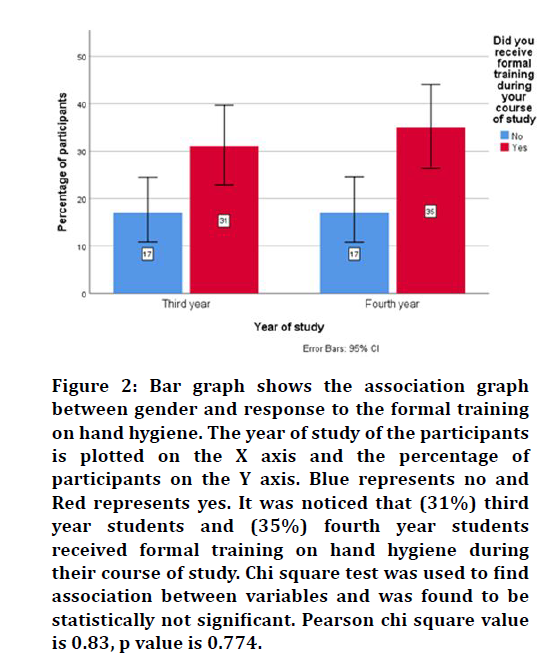
Figure 2. Bar graph shows the association graph between gender and response to the formal training on hand hygiene. The year of study of the participants is plotted on the X axis and the percentage of participants on the Y axis. Blue represents no and Red represents yes. It was noticed that (31%) third year students and (35%) fourth year students received formal training on hand hygiene during their course of study. Chi square test was used to find association between variables and was found to be statistically not significant. Pearson chi square value is 0.83, p value is 0.774.
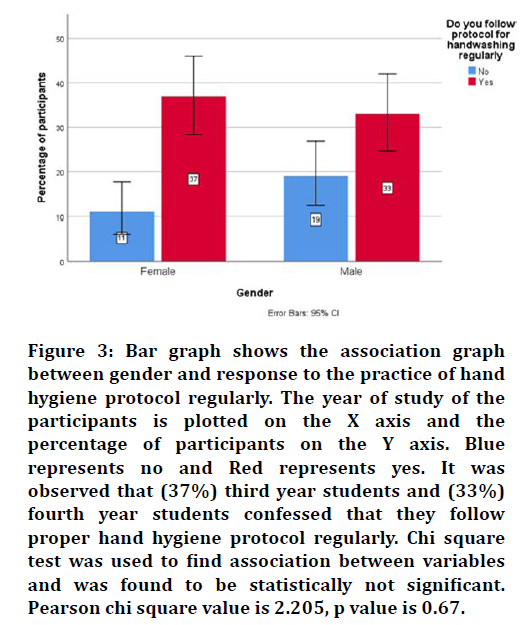
Figure 3. Bar graph shows the association graph between gender and response to the practice of hand hygiene protocol regularly. The year of study of the participants is plotted on the X axis and the percentage of participants on the Y axis. Blue represents no and Red represents yes. It was observed that (37%) third year students and (33%) fourth year students confessed that they follow proper hand hygiene protocol regularly. Chi square test was used to find association between variables and was found to be statistically not significant. Pearson chi square value is 2.205, p value is 0.67.
In Figure 4, 54% of students answered that 20 seconds is the minimum time for handwashing whereas the rest answered it as 10 seconds, 30 seconds and 40 seconds. Collectively among males and females, females answered 20 seconds to be the minimal time for handwashing than males. In Figure 5, 52% of students answered antimicrobial soap and water to be the most effective method for hand hygiene, whereas 30% answered alcohol-based hand rub and the rest 12% answered plain soap and water. Collectively among males and females, females answered alcohol based handrub to be the most effective hand hygiene method than males. In Figure 6, 43% of students told that there are 7 steps in handwashing whereas 23% told 8 steps, 25% told 3 steps and 9% told 9 steps. Collectively among males and females, males replied that there are 8 steps in handwashing than females.
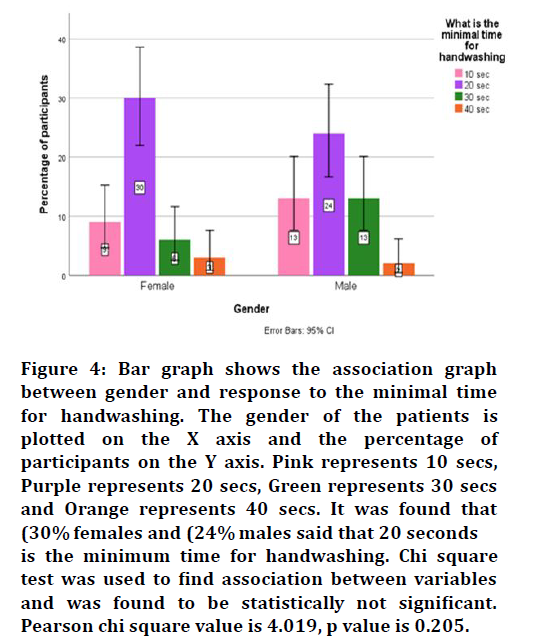
Figure 4. Bar graph shows the association graph between gender and response to the minimal time for handwashing. The gender of the patients is plotted on the X axis and the percentage of participants on the Y axis. Pink represents 10 secs, Purple represents 20 secs, Green represents 30 secs and Orange represents 40 secs. It was found that (30% females and (24% males said that 20 seconds is the minimum time for handwashing. Chi square test was used to find association between variables and was found to be statistically not significant. Pearson chi square value is 4.019, p value is 0.205.
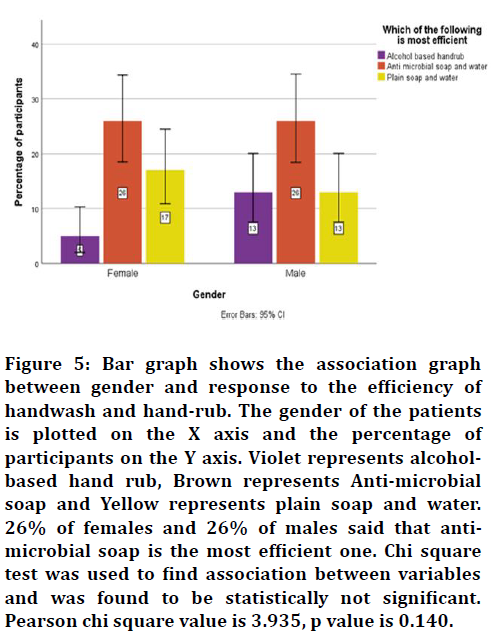
Figure 5. Bar graph shows the association graph between gender and response to the efficiency of handwash and hand-rub. The gender of the patients is plotted on the X axis and the percentage of participants on the Y axis. Violet represents alcoholbased hand rub, Brown represents Anti-microbial soap and Yellow represents plain soap and water. 26% of females and 26% of males said that antimicrobial soap is the most efficient one. Chi square test was used to find association between variables and was found to be statistically not significant. Pearson chi square value is 3.935, p value is 0.140.
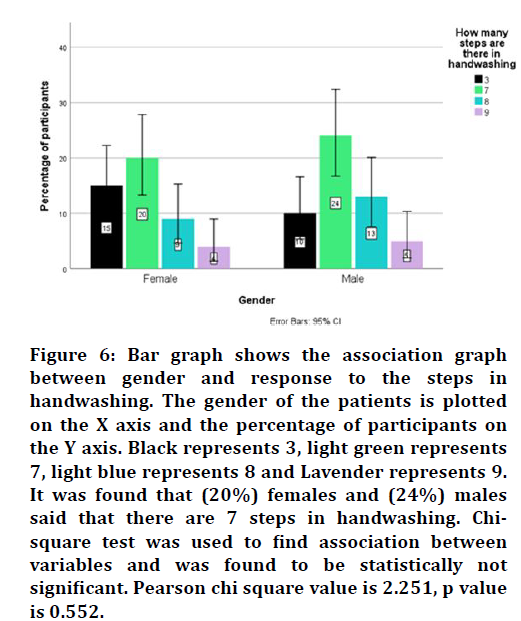
Figure 6. Bar graph shows the association graph between gender and response to the steps in handwashing. The gender of the patients is plotted on the X axis and the percentage of participants on the Y axis. Black represents 3, light green represents 7, light blue represents 8 and Lavender represents 9. It was found that (20%) females and (24%) males said that there are 7 steps in handwashing. Chisquare test was used to find association between variables and was found to be statistically not significant. Pearson chi square value is 2.251, p value is 0.552.
In Figure 7, 51% of students replied that gloves do not eliminate the need for hand hygiene whereas 34% told that gloves does eliminate the need for hand hygiene and 15% of students did not know and were not sure.
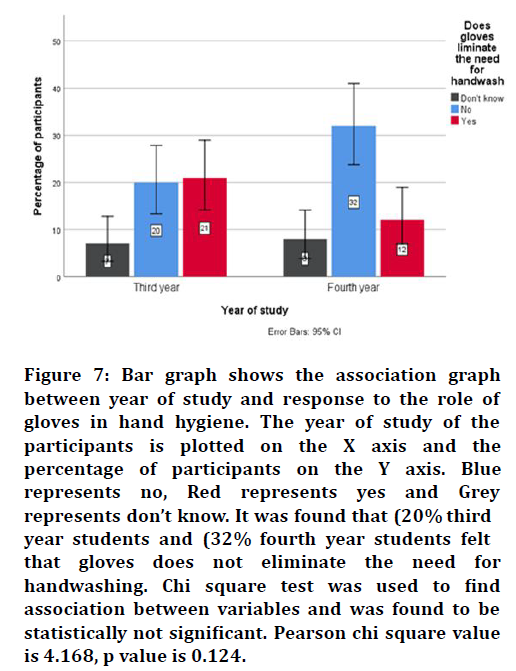
Figure 7. Bar graph shows the association graph between year of study and response to the role of gloves in hand hygiene. The year of study of the participants is plotted on the X axis and the percentage of participants on the Y axis. Blue represents no, Red represents yes and Grey represents don’t know. It was found that (20% third year students and (32% fourth year students felt that gloves does not eliminate the need for handwashing. Chi square test was used to find association between variables and was found to be statistically not significant. Pearson chi square value is 4.168, p value is 0.124.
Collectively among third and fourth years, fourth years were more aware that gloves do not eliminate the need for hand hygiene than males.
In Figure 8, 64% of students were aware about the five moments of hand hygiene whereas 36% of students were not aware about the five moments of hand hygiene. Collectively among males and females, males were more aware about the five moments of hand hygiene than females.
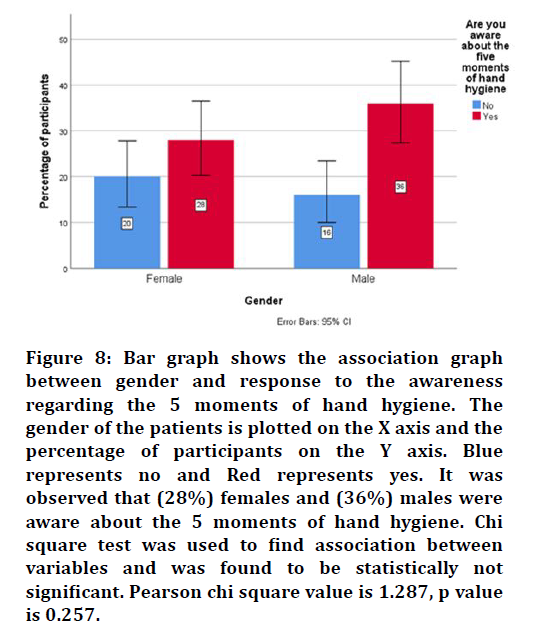
Figure 8. Bar graph shows the association graph between gender and response to the awareness regarding the 5 moments of hand hygiene. The gender of the patients is plotted on the X axis and the percentage of participants on the Y axis. Blue represents no and Red represents yes. It was observed that (28%) females and (36%) males were aware about the 5 moments of hand hygiene. Chi square test was used to find association between variables and was found to be statistically not significant. Pearson chi square value is 1.287, p value is 0.257.
Discussion
In our study, the majority of females (44%) and males (37%) were aware of the hand hygiene protocol. Previous study showed 81% of students were aware about hand hygiene while 44% students were either unaware or not sure about the hand hygiene measures. This is comparable to the results that have been reported in literature [40]. In support of the results obtained in this study we also have another study with similar results where 98% of dental students were surprisingly aware about the importance of hand hygiene which is the best result obtained when compared to all the studies conducted so far. This data is higher than the previous studies conducted in Indian students [41].
According to our study, 35% fourth year students and 31% third year students have received formal training regarding hand hygiene. Another study conducted states that compliance of hand hygiene is directly linked to the year of study and so proper training must be provided for all year students equally with the same amount of importance. Repeated instructions on the same topic are necessary for improving hand hygiene compliance. This finding has also been noticed in another study where compliance to hand hygiene decreases [42].
According to our study, the majority of the third-year students (37%) and fourth year students (31%) follow proper hand hygiene protocol. Previous study tells that 5% medical students routinely used hand rub for hand hygiene as compared to 15% dental students [43,44]. Proper handwashing technique is an integral part of patient and self-health care and it has to be followed properly. This can be done only if awareness about the topic is high in medical and dental students. Healthcare associated infections are quite high nowadays and these medical and dental students are the future health care providers. It’s very important for them to incorporate the basic hand hygiene practice in their routine patient care [45,46].
In our study, the majority of the females (30%) and males (24%) answered that 20 seconds is the minimum time required for handwashing. The World Health Organization (WHO) and the Center for Disease Control (CDC) recommend stringent hand hygiene practices to curb transmission of COVID-19 virus [47]. This includes frequent handwashing with soap for at least 20 seconds to mechanically remove the pathogens. The ideal duration of hand washing is controversial. Mackintosh and Hoffman observed that hand hygiene is exclusively diverted to flora rather than to the surgical scrub, which is concerned with reducing the total number of bacteria on the hand [48]. Other studies reported that handwashing could be done in 15 seconds or less [49]. 9.5 seconds was the average time required for hand washing which was observed in the study conducted by Meengs et al. So, it was found to be ineffective [50].
In our study, the majority of the females and males (26%) stated that anti-microbial soap is the most efficient method for handwashing. Another study revealed that soap was found to be the preferred means of maintaining hand hygiene predominantly followed by both soap and antiseptic hand rub (35%). Results obtained are better when compared to previous studies where only 9-14% students use antiseptic hand rub [17]. A study conducted by Rashmi et al showed that antimicrobial agents like triclosan, chlorhexidine, and chloroxylenol to soaps do not exhibit higher potential advantage and rather increase the chances of irritant contact dermatitis [51].
In our study, the majority of the females (20%) and males (23%) said that there are 7 steps involved in hand washing. A study carried out by Friedrich et al showed that recommendations for effective hand hygiene should include moistening hands under a tap, soap use and performing specific scrubbing steps, including scrubbing under the fingernails and scrubbing the fingertips. Henceforth, the study suggests that inclusion of a minimum wash or scrubbing time may complicate recommendations without providing any additional bacterial removal [52].
According to our study, the majority of the third-year students (20%) and fourth year students (31%) agreed that gloves do not eliminate the need for handwashing. Gloves are believed to act as a barrier against microorganisms that protects health care workers and prevents the transmission of infectious diseases. Hence, gloves can provide a false sense of security. According to the CDC, the use of gloves reduces the risk of contamination 70 to 80 percent, helps prevent cross contamination and helps protect patients and providers [53]. A pseudo protection can be felt while using gloves, whereas gloves yield a new surface for a virus to reside. Gloves do not provide adequate protection; rather, it increases the chance of cross transmission of infection [54].
In our study, the majority of the females (28%) and males (36%) were aware about the five moments of hand hygiene proposed by WHO. Sax et al in his study described a new model for hand hygiene that is focused to meet the needs for training, observation, and performance reporting across all healthcare settings worldwide. The model ‘My five moments for hand hygiene’ was created to bridge the gap between the results of scientific studies and evidence-based guidelines and the necessity to provide user-cantered, practical tools [55,56].
Conclusion
Within the limitations of the study, it can be concluded that dental students were well aware about the hand hygiene protocol and its importance. Among the study population females were more aware about hand hygiene protocol and its importance than the males. However, hand hygiene practices to be followed and awareness must be created to a larger population of students.
Acknowledgement
The authors would like to acknowledge the help support rendered by Saveetha dental college and hospital, Saveetha Institute of Medical and Technical Sciences, Saveetha University, Chennai, India.
Funding Support
The present project is funded by Saveetha Institute of Medical and Technical sciences, Saveetha Dental College and Hospitals, Saveetha University, Royal Medicals, India.
Conflicts of Interest
The authors declare no potential conflict of interest.
References
- https://pubmed.ncbi.nlm.nih.gov/23805438/
- Pittet D, Hugonnet S, Harbarth S, et al. Effectiveness of a hospital-wide programme to improve compliance with hand hygiene. Lancet 2000; 356:1307-1312.
- Longtin Y, Sax H, Allegranzi B, et al. Hand hygiene. N Engl J Med 2011; 364:e24.
- Trampuz A, Widmer AF. Hand hygiene: A frequently missed lifesaving opportunity during patient care. Mayo Clin Proc 2004; 79:109-116.
- Kenyon M, Babic A. The European blood and marrow transplantation textbook for nurses: Under the auspices of EBMT. Springer 2018; 311.
- Bommireddy VS, Pachava S, Sanikommu S, et al. Infection control measures among dental practitioners in a Southern state of India: A cross-sectional study. J Indian Assoc Public Health Dent 2016; 14:302.
- Giriraju A. Perception about self-medication practices for oral health problems among the general population of Davangere city, Karnataka, India. J Indian Assoc Public Health Dent 2014; 12:219.
- Rameswarapu R, Surendranath SK, Valsangkar S. Assessment of hand hygiene levels among healthcare professionals in India. Int J Biomed Adv Res 2015; 6:107.
- Walker J. Decontamination in hospitals and healthcare. Wood Head Publishing 2014; 704.
- Ellingson K, Haas JP, Aiello AE, et al. Strategies to prevent healthcare-associated infections through hand hygiene. Infection Control Hospital Epidemiol 2014; 35:937-960.
- Limper HM, Barton G, McGinty M, et al. Behavioral intention of physician trainees and medical students to practice hand hygiene. Infect Control Hosp Epidemiol 2013; 34:1102-1105.
- Mortel TF van de, van de Mortel TF, Apostolopoulou E, et al. A comparison of the hand hygiene knowledge, beliefs, and practices of Greek nursing and medical students. Am J Infect Control 2010; 38:75-77.
- Ejemot RI, Ehiri JE, Meremikwu MM, et al. Hand washing for preventing diarrhoea. Cochrane Database Syst Rev 2008; CD004265.
- Aiello AE, Coulborn RM, Perez V, et al. Effect of hand hygiene on infectious disease risk in the community setting: A meta-analysis. Am J Public Health 2008; 98:1372-1381.
- Rabie T, Curtis V. Handwashing and risk of respiratory infections: A quantitative systematic review. Trop Med Int Health 2006; 11:258-267.
- Bogomolov V. The moment of truth: A novel and two stories. Raduga Publishers 1982.
- Thakker VS, Jadhav PR. Knowledge of hand hygiene in undergraduate medical, dental, and nursing students: A cross-sectional survey. J Family Med Prim Care 2015; 4:582.
- Chase McNeil J, Campbell JR, Crews JD. Healthcare-associated infections in children: A guide to prevention and management. Springer 2018; 351.
- Lopez AD. Global burden of disease and risk factors. World Bank Publications 2006; 475.
- Pc J, Marimuthu T, Devadoss P, et al. Prevalence and measurement of anterior loop of the mandibular canal using CBCT: A cross sectional study. Clin Implant Dent Related Res 2018; 20:531-534.
- Wahab PA, Madhulaxmi M, Senthilnathan P, et al. Scalpel versus diathermy in wound healing after mucosal incisions: A split-mouth study. J Oral Maxillofac Surg 2018; 76:1160-1164.
- kiran Mudigonda S, Murugan S, et al. Non-suturing microvascular anastomosis in maxillofacial reconstruction-a comparative study. J Craniomaxillofac Surg 2020; 48:599-606.
- Narayanasamy RK, Muthusekar RM, Nagalingam SP, et al. Lower pretreatment hemoglobin status and treatment breaks in locally advanced head and neck squamous cell carcinoma during concurrent chemoradiation. Indian J Cancer 2021; 58:62.
- Wang H, Chinnathambi A, Alahmadi TA, et al. Phyllanthin inhibits MOLT-4 leukemic cancer cell growth and induces apoptosis through the inhibition of AKT and JNK signaling pathway. J Biochem Mol Toxicol 2021; 35:1-10.
- Li S, Zhang Y, Veeraraghavan VP, et al. Restorative effect of fucoxanthin in an ovalbumin-induced allergic rhinitis animal model through NF-B p65 and STAT3 Signaling. J Environ Pathol Toxicol Oncol 2019; 38:365-375.
- Ma Y, Karunakaran T, Veeraraghavan VP, et al. Sesame inhibits cell proliferation and induces apoptosis through inhibition of STAT-3 translocation in thyroid cancer cell lines (FTC-133). Biotechnol Bioprocess Eng 2019; 24:646-652.
- Bishir M, Bhat A, Essa MM, et al. Sleep deprivation and neurological disorders. Biomed Res Int 2020; 2020:5764017.
- Fan Y, Maghimaa M, Chinnathambi A, et al. Tomentosin reduces behavior deficits and neuroinflammatory response in MPTP-induced parkinson’s disease in mice. J Environ Pathol Toxicol Oncol 2021; 40:75-84.
- Zhang C, Chen Y, Zhang M, et al. Vicenin-2 Treatment attenuated the diethylnitrosamine-induced liver carcinoma and oxidative stress through increased apoptotic protein expression in experimental rats. J Environ Pathol Toxicol Oncol 2020; 39:113-23.
- Gan H, Zhang Y, Zhou Q, et al. Zingerone induced caspase-dependent apoptosis in MCF-7 cells and prevents 7,12-dimethylbenz(a)anthracene-induced mammary carcinogenesis in experimental rats. J Biochem Mol Toxicol 2019; 33:e22387.
- Saravanakumar K, Park S, Mariadoss AVA, et al. Chemical composition, antioxidant, and anti-diabetic activities of ethyl acetate fraction of Stachys riederi var. japonica (Miq.) in streptozotocin-induced type 2 diabetic mice. Food Chem Toxicol 2021; 155:112374.
- Veeraraghavan VP, Hussain S, Papayya Balakrishna J, et al. A comprehensive and critical review on ethnopharmacological importance of desert truffles: Terfezia claveryi, terfezia boudieri, and Tirmania nivea. Food Rev Int 2021; 1-20.
- Wei W, Li R, Liu Q, et al. Amelioration of oxidative stress, inflammation and tumor promotion by tin oxide-sodium alginate-polyethylene glycol-allyl isothiocyanate nanocomposites on the 1,2-Dimethylhydrazine induced colon carcinogenesis in rats. Arabian J Chem 2021; 14:103238.
- Sathya S, Ragul V, Veeraraghavan VP, et al. An in vitro study on hexavalent chromium [Cr(VI)] remediation using iron oxide nanoparticles based beads. Environ Nanotechnol Monitoring Manag 2020; 14:100333.
- Chandrasekar R, Chandrasekhar S, Sundari KKS, et al. Development and validation of a formula for objective assessment of cervical vertebral bone age. Prog Orthod 2020; 21:38.
- Ramakrishnan M, Dhanalakshmi R, Subramanian EM. Survival rate of different fixed posterior space maintainers used in paediatric dentistry-A systematic review. Saudi Den J 2019; 31:165-72.
- Felicita AS. Orthodontic extrusion of ellis class VIII fracture of maxillary lateral incisor-The sling shot method. Saudi Dent J 2018; 30:265-269.
- Su P, Veeraraghavan VP, Krishna Mohan S, et al. A ginger derivative, zingerone-a phenolic compound-induces ROS-mediated apoptosis in colon cancer cells (HCT-116). J Biochem Mol Toxicol 2019; 33:e22403.
- Wan J, Feng Y, Du L, et al. Antiatherosclerotic activity of eriocitrin in high-fat-diet-induced atherosclerosis model rats. J Environ Pathol Toxicol Oncol 2020; 39:61-75.
- Amissah I, Salia S, Craymah JP. A Study to assess hand hygiene knowledge and practices among health care workers in a teaching hospital in Ghana. IJSR. 2016; 5:301-307.
- Nair SS, Hanumantappa R, Hiremath SG, et al. Knowledge, attitude, and practice of hand hygiene among medical and nursing students at a tertiary health care centre in Raichur, India. Preventive Med 2014; 1-4.
- Roberto MS, Mearns K, Silva SA. Social and moral norm differences among Portuguese 1st and 6th year medical students towards their intention to comply with hand hygiene. Psychol Health Med 2012; 17:408-16.
- Huis A, van Achterberg T, de Bruin M, et al. A systematic review of hand hygiene improvement strategies: A behavioural approach. Implement Sci 2012; 7.
- Almedom AM, Blumenthal U, Manderson L. Hygiene evaluation procedures: Approaches and methods for assessing water-and sanitation-related hygiene practices. Prac Action 2015; 118.
- Park JH, Kim HS. The effect of the hand hygiene education program on hand hygiene knowledge, hand hygiene perception, nasal staphylococcus aureus colonization and hand hygiene adherence in nursing students. J Korean Biol Nurs Sci 2012; 14:156-165.
- Al Kadi A, Salati SA. Hand hygiene practices among medical students. Interdiscip Perspect Infect Dis 2012; 2012.
- https://www.simonandschuster.com/books/Coronavirus/The-Centers-for-Disease-Controls-Website/9781952438981
- Mackintosh CA, Hoffman PN. An extended model for transfer of micro-organisms via the hands: Differences between organisms and the effect of alcohol disinfection. Epidemiol Infection 1984; 92:345-355.
- Sprunt K, Redman W, Leidy G. Antibacterial effectiveness of routine hand washing. Pediatr 1973; 52:264-271.
- Centers for Disease Control (CDC). Public health focus: Surveillance, prevention, and control of nosocomial infections. MMWR. Morbidity and mortality weekly report. 1992; 41:783-787.
- Allegranzi B, Memish ZA, Donaldson L, et al. Religion and culture: Potential undercurrents influencing hand hygiene promotion in health care. Am J Infec Control 2009; 37:28-34.
- Pickering AJ, Davis J, Walters SP, et al. Hands, water, and health: Fecal contamination in Tanzanian communities with improved, non-networked water supplies. Environ Sci Technol 2010; 44:3267-3272.
- www.cdc.gov/od/oc/media/pressrel/fs021025. htm
- Goyal MK. Integrated risk of pandemic: Covid-19 impacts, resilience and recommendations. Springer Nature.
- Quality AFHRA. Making health care safe: A critical analysis of patient safety practices. Am J Cosmetic Surg 2001; 18:215-224.
- Landrigan CP, Rothschild JM, Cronin JW, et al. Effect of reducing interns’ work hours on serious medical errors in intensive care units. N Engl J Med 2004; 351:1838-1848.
Indexed at, Google Scholar, Cross Ref,
Indexed at, Google Scholar, Cross Ref,
Indexed at, Google Scholar, Cross Ref,
Indexed at, Google Scholar, Cross Ref,
Indexed at, Google Scholar, Cross Ref,
Indexed at, Google Scholar, Cross Ref,
Indexed at, Google Scholar, Cross Ref,
Indexed at, Google Scholar, Cross Ref,
Indexed at, Google Scholar, Cross Ref,
Indexed at, Google Scholar, Cross Ref,
Indexed at, Google Scholar, Cross Ref,
Indexed at, Google Scholar, Cross Ref,
Indexed at, Google Scholar, Cross Ref,
Indexed at, Google Scholar, Cross Ref,
Indexed at, Google Scholar, Cross Ref,
Indexed at, Google Scholar, Cross Ref,
Indexed at, Google Scholar, Cross Ref,
Indexed at, Google Scholar, Cross Ref,
Indexed at, Google Scholar, Cross Ref,
Indexed at, Google Scholar, Cross Ref,
Indexed at, Google Scholar, Cross Ref,
Indexed at, Google Scholar, Cross Ref,
Indexed at, Google Scholar, Cross Ref,
Indexed at, Google Scholar, Cross Ref,
Indexed at, Google Scholar, Cross Ref,
Indexed at, Google Scholar, Cross Ref,
Indexed at, Google Scholar, Cross Ref,
Indexed at, Google Scholar, Cross Ref,
Indexed at, Google Scholar, Cross Ref,
Indexed at, Google Scholar, Cross Ref,
Indexed at, Google Scholar, Cross Ref,
Indexed at, Google Scholar, Cross Ref,
Indexed at, Google Scholar, Cross Ref,
Indexed at, Google Scholar, Cross Ref,
Indexed at, Google Scholar, Cross Ref,
Indexed at, Google Scholar, Cross Ref,
Indexed at, Google Scholar, Cross Ref,
Author Info
Aathira CM and Santhosh Kumar MP*
Department of Oral Surgery, Saveetha Dental College, Saveetha Institute of Medical and Technical Sciences, Saveetha University, Chennai, IndiaReceived: 06-Jan-2022, Manuscript No. JRMDS-22-46345; , Pre QC No. JRMDS-22-46345 (PQ); Editor assigned: 10-Jan-2022, Pre QC No. JRMDS-22-46345 (PQ); Reviewed: 24-Jan-2022, QC No. JRMDS-22-46345; Revised: 28-Jan-2022, Manuscript No. JRMDS-22-46345 (R); Published: 04-Feb-2022
